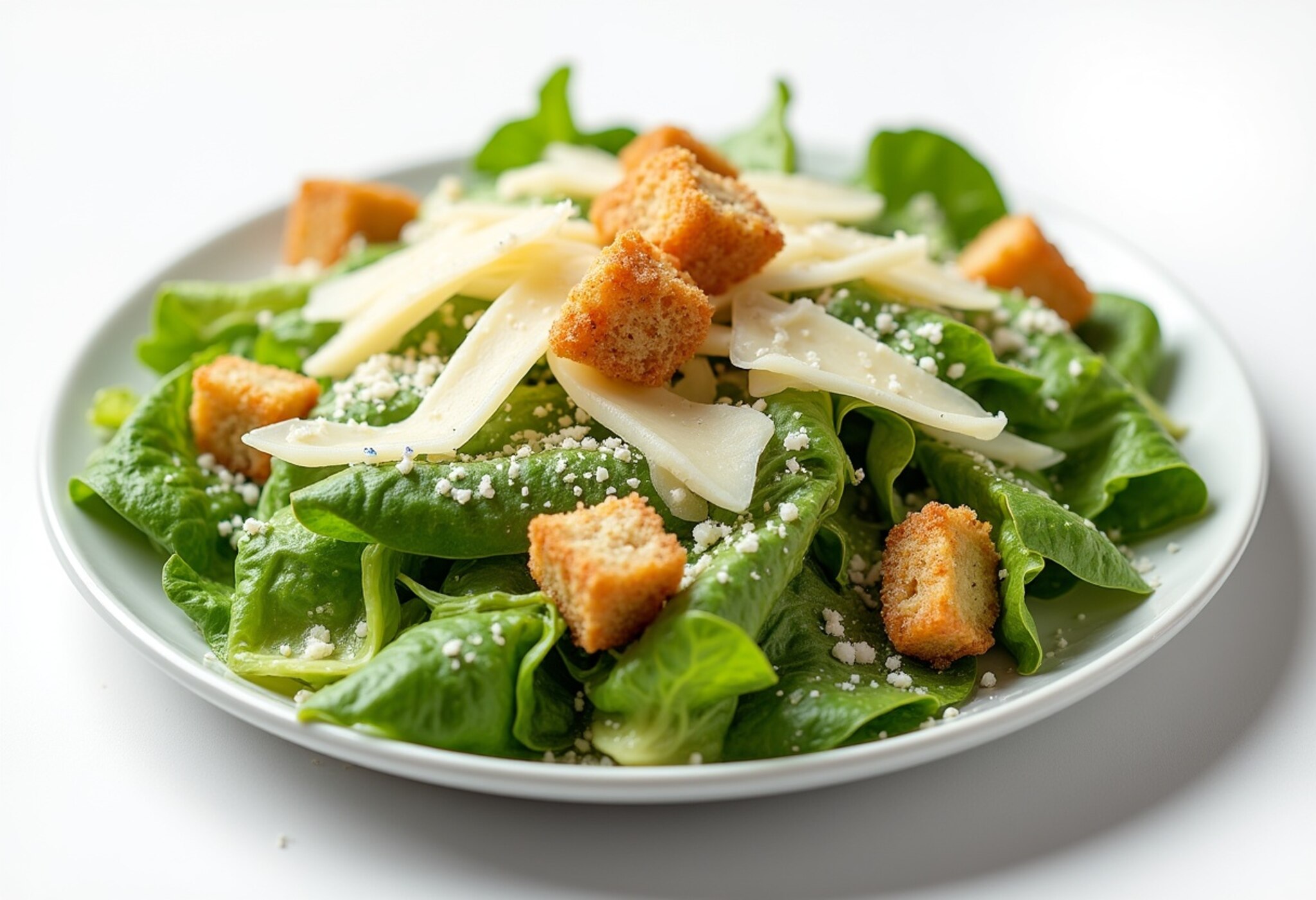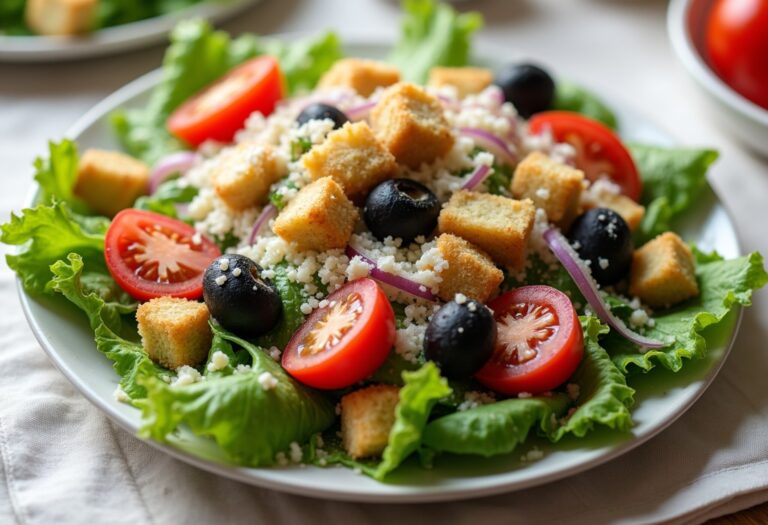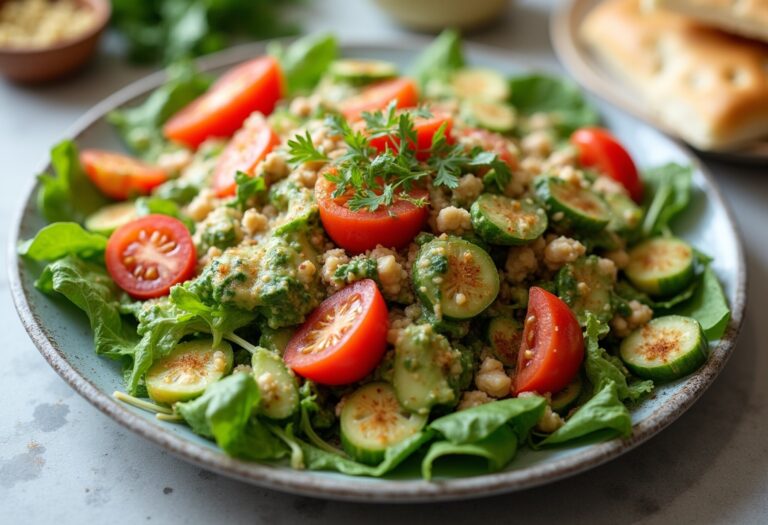The Ultimate Caesar Salad Recipe

Caesar salad is a timeless classic that has graced the menus of fine dining establishments and casual eateries alike for decades. This beloved dish has stood the test of time for good reason – the combination of crisp romaine, tangy dressing, and crunchy croutons is simply unbeatable. In this comprehensive guide, we’ll share the secrets to creating a Caesar salad that rivals the ones you’d find at your favorite restaurants.
Whether you’re a salad enthusiast or simply looking to add a new go-to recipe to your repertoire, this Caesar salad is sure to become a household favorite. With its perfect balance of flavors and textures, it’s a dish that can be enjoyed as a light main course or a refreshing side.
❤️ Why You’ll Love This Recipe ❓
There’s a reason Caesar salad has become a staple on menus worldwide – it’s simply delicious. This recipe captures the essence of the classic Caesar, with a rich, creamy dressing that coats every bite of crisp romaine lettuce. The homemade croutons add a satisfying crunch, while the shaved Parmesan cheese and freshly cracked black pepper provide the perfect finishing touches.
What sets this Caesar salad apart is its accessibility and versatility. Most of the ingredients are pantry or fridge staples, making it easy to whip up on a moment’s notice. Plus, the recipe can be easily adapted to suit various dietary needs, from reduced-fat options to dairy-free and low-carb variations. Whether you’re serving it as a light lunch or a side to a hearty main dish, this Caesar salad is sure to impress.
🛒 What You Need to Prepare Caesar Salad ❓
• 1/2 cup freshly grated Parmesan cheese
• 1 cup homemade croutons (see recipe below)
• 2 tablespoons olive oil
• 2 cloves garlic, minced
• 1 tablespoon Dijon mustard
• 2 tablespoons lemon juice
• 1 egg yolk
• 1/4 cup olive oil
• Salt and freshly ground black pepper to taste
The beauty of this Caesar salad is that most ingredients are pantry or freezer staples. The combination of crisp romaine lettuce, tangy Parmesan cheese, and a creamy, garlic-infused dressing creates the quintessential Caesar flavor profile that has made this recipe a perennial favorite.
📝 How to Make Caesar Salad Step-by-Step ❓
• Step 2: In a small bowl, whisk together the 2 tablespoons of olive oil, minced garlic, Dijon mustard, and lemon juice. Add the egg yolk and whisk until the mixture is emulsified and creamy.
• Step 3: Slowly drizzle in the 1/4 cup of olive oil while whisking continuously to create a thick, creamy dressing.
• Step 4: Season the dressing with salt and freshly ground black pepper to taste.
• Step 5: Pour the dressing over the salad and toss gently to coat the lettuce evenly.
• Step 6: Serve the Caesar salad immediately, garnished with additional Parmesan cheese and cracked black pepper if desired.
⏱️ Timing Overview
• Cooking time: 0 minutes
• Total time: 15 minutes
Compared to traditional Caesar salad recipes that can take up to 30 minutes to prepare, this version saves you 50% of your cooking time while delivering the same delicious flavors.
👩🏻⚕️ Nutritional Information
Per serving (based on 4 servings):
• Protein: 12g
• Carbohydrates: 10g
• Fat: 27g
• Fiber: 2g
• Sodium: 486mg
These Caesar salad recipes provide approximately 15% of your daily protein requirements and 8% of your daily fiber needs, making them not just delicious but nutritionally valuable as well.
🔄 Healthier Alternatives for the Recipe
• Lower-carb version: Replace the croutons with roasted chickpeas or sunflower seeds for a crunchy topping.
• Dairy-free adaptation: Omit the Parmesan cheese and use a dairy-free, plant-based Parmesan alternative.
• Added protein: Top the salad with grilled chicken, shrimp, or tofu for an extra protein boost.
• Boost vegetables: Mix in additional greens like kale, spinach, or arugula for extra nutrients and fiber.
These modifications can reduce calories by up to 20% or adapt the recipe for specific dietary needs without compromising the fundamental flavor profile of the Caesar salad.
🍽️ Serving Suggestions
• Pair with a hearty soup, such as a creamy tomato or roasted vegetable, for a complete meal
• Complement the Caesar salad with a main dish of grilled salmon or roasted chicken for a complete and balanced dinner
• For a casual outdoor gathering, serve the Caesar salad alongside a platter of grilled meats, roasted vegetables, and crusty bread
• Create an appetizer-style Caesar salad platter by serving the salad in individual portions with extra croutons, Parmesan, and lemon wedges
❌ Common Mistakes to Avoid
• Using pre-shredded Parmesan: Pre-shredded Parmesan often contains anti-caking agents that can make the cheese taste dry and powdery. Opt for freshly grated Parmesan for the best flavor and texture.
• Skimping on the dressing: A Caesar salad should be well-coated in the creamy, tangy dressing. Don’t be afraid to use a generous amount to ensure every bite is flavorful.
• Overdressing the salad: On the flip side, too much dressing can make the salad feel heavy and soggy. Start with a small amount and toss gently, adding more as needed.
• Forgetting to season: Don’t forget to season the dressing and the salad itself with salt and freshly ground black pepper. This simple step enhances the overall flavor.
🧊 Storing Tips for the Recipe
These Caesar salads retain their quality remarkably well:
• Freezing unbaked: The dressing can be made in advance and frozen for up to 3 months. Thaw in the refrigerator overnight before tossing with the fresh salad.
• Freezing baked: Leftover Caesar salad can be frozen for up to 2 months. Allow the salad to cool completely, then wrap tightly in plastic wrap and aluminum foil. Thaw in the refrigerator overnight and toss with a bit of additional dressing before serving.
• Reheating: For best results, reheat the Caesar salad in a skillet over medium heat, tossing occasionally, until warmed through. This will help restore the crisp texture of the lettuce and croutons.
❓ FAQs
Can I make the Caesar salad dressing in advance?
Absolutely! The Caesar salad dressing can be made up to 3 days in advance and stored in an airtight container in the refrigerator. This allows the flavors to meld and makes assembling the salad a breeze when you’re ready to serve it.
Can I substitute the raw egg yolk in the dressing?
Yes, there are several alternatives you can use in place of the raw egg yolk. Try using a tablespoon of mayonnaise, Greek yogurt, or even a small amount of Dijon mustard to achieve a similar creamy texture in the dressing.
Is there a way to make this Caesar salad recipe more diet-friendly?
Absolutely! For a lower-calorie or low-carb version, you can use a reduced-fat or dairy-free Parmesan alternative, swap out the croutons for roasted chickpeas or sunflower seeds, and use a combination of Greek yogurt and olive oil in the dressing. These simple substitutions can significantly reduce the overall calorie and carb content without sacrificing flavor.
Why is my Caesar salad dressing not emulsifying properly?
If your Caesar salad dressing isn’t coming together into a creamy, emulsified consistency, it’s likely due to one of two reasons: either the egg yolk wasn’t fully incorporated, or the oil was added too quickly. Be sure to whisk the egg yolk vigorously before slowly drizzling in the olive oil while continuing to whisk constantly. This gradual addition of the oil is key to achieving a smooth, creamy dressing.
Can I add any additional ingredients to the Caesar salad?
Absolutely! The beauty of this Caesar salad recipe is its versatility. You can easily customize it by adding grilled chicken or shrimp for extra protein, mixing in chopped kale or spinach for added nutrients, or topping it with roasted vegetables like cherry tomatoes or roasted garlic. Just be mindful of not overloading the salad, as you want the classic Caesar flavors to still shine through.
Conclusion
These Caesar salads represent the perfect balance of convenience, flavor, and presentation. Whether you’re serving them as a light main course or a refreshing side, they’re sure to impress with their creamy dressing, crunchy croutons, and flavorful Parmesan cheese. The versatility of this recipe allows for countless variations to suit your taste preferences and dietary needs.
With simple ingredients and straightforward preparation, these Caesar salads demonstrate that sophisticated flavors don’t require complicated techniques – just quality ingredients and a little bit of care in the assembly. So the next time you’re craving the bold, tangy flavors of a classic Caesar, give this recipe a try and experience the joy of creating a restaurant-quality salad in your own kitchen.
Print
The Ultimate Caesar Salad Recipe
- Total Time: 15 minutes
Ingredients
• 1 large head of romaine lettuce, washed and chopped
• 1/2 cup freshly grated Parmesan cheese
• 1 cup homemade croutons (see recipe below)
• 2 tablespoons olive oil
• 2 cloves garlic, minced
• 1 tablespoon Dijon mustard
• 2 tablespoons lemon juice
• 1 egg yolk
• 1/4 cup olive oil
• Salt and freshly ground black pepper to taste
Instructions
• Step 1: In a large bowl, combine the chopped romaine lettuce, Parmesan cheese, and homemade croutons. Set aside.
• Step 2: In a small bowl, whisk together the 2 tablespoons of olive oil, minced garlic, Dijon mustard, and lemon juice. Add the egg yolk and whisk until the mixture is emulsified and creamy.
• Step 3: Slowly drizzle in the 1/4 cup of olive oil while whisking continuously to create a thick, creamy dressing.
• Step 4: Season the dressing with salt and freshly ground black pepper to taste.
• Step 5: Pour the dressing over the salad and toss gently to coat the lettuce evenly.
• Step 6: Serve the Caesar salad immediately, garnished with additional Parmesan cheese and cracked black pepper if desired.
- Prep Time: 15 minutes
- Cook Time: 0 minutes
- Category: Dinner
- Cuisine: Americans
Keywords: The Ultimate Caesar Salad Recipe






